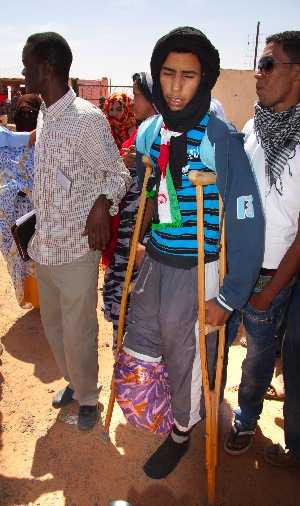
Whilst the world is commemorating the fall of the Berlin Wall another less well-known wall that separates a nation and its people still stands tall. At 1553 miles long, the wall that divides Western Sahara, is twelve times longer than the Berlin Wall and, having stood for 29 years, is now a year older than the Berlin Wall was when it was toppled.
Known as ‘the Berm’, the wall was constructed by the Moroccans from sand and stone to keep the Polisario Front, the Western Sahara liberation movement, out of the territory and prevent the 165,000 Saharawi refugees from returning to their land. Standing at around 3m in height, the wall runs through desert and is fortified with barbed-wire fencing, artillery posts and among the highest density of land mines in the world.
 Like the wall that separates the Israeli and Palestinian populations in the West Bank, the Berm has become a potent symbol of the occupation and focus for protests. Last April nineteen-year-old Ibrahim Hussein Leibeit was taking part in one of the frequent marches to the wall organised by Saharawi’s living in the refugee camps. In a symbolic gesture, Ibrahim was attempting to get close enough to the wall to throw a pebble to the other side when he trod a land mine. He lost his right leg below the knee and in the following months he has become something of a hero to the Saharawi cause.
Like the wall that separates the Israeli and Palestinian populations in the West Bank, the Berm has become a potent symbol of the occupation and focus for protests. Last April nineteen-year-old Ibrahim Hussein Leibeit was taking part in one of the frequent marches to the wall organised by Saharawi’s living in the refugee camps. In a symbolic gesture, Ibrahim was attempting to get close enough to the wall to throw a pebble to the other side when he trod a land mine. He lost his right leg below the knee and in the following months he has become something of a hero to the Saharawi cause.
Unlike the Berlin Wall or the wall in Palestine, only a few people have heard either of the Berm or the conflict in Western Sahara, which remains one of the longest running conflicts in the world. About the size of Britain, Western Sahara lies along Africa’s Atlantic coast. It was colonised by Spain, but in 1976, in a breach of international law, the Spanish colonisers divided Western Sahara between Morocco and Mauritainia in exchange for continued fishing rights and partial ownership of mining interests. A fifteen-year war ensued between the Moroccans and the Western Saharan liberation movement, the Polisario Front. The Mauritanians withdrew in 1979. The fighting was brutal, with Morocco using her well equipped army and air-force to full effect but the Saharawi’s conducting an effective counter insurgency. In 1980 the Moroccan’s began constructing the Berm to try and contain the Polisario but with little success. In 1991 a ceasefire was declared and under the terms of a UN agreement a referendum for self-determination was promised. Seventeen years later the Saharawi are still awaiting that referendum.
Virtually all Saharawi from Western Sahara have experienced some form of separation from their family as a result of the Berm. Aziza Brahim, 33, was born in exile in a refugee camp in Algeria, her mother having carried her across the border from Western Sahara in her womb as she fled the advance of Moroccan occupying armies in 1976. “I never got the chance to meet my father before he died,” says Brahim who’s father remained in Western Sahara. “The pain of this is carved into my spine”. She still has brothers in the so-called ‘occupied zone’ with whom the only contact she has had has been by telephone. Through the negotiation process, some family exchanges have been arranged and the lucky few families have had fleeting and emotional reunions for the first time in over three decades.
Whilst it is estimated well over a hundred people died trying to escape over the Berlin Wall to the West, the figure for the number of people killed or injured trying to cross the Berm remains unknown. When I met Ibrahim Hussein Leibeit, just weeks after he had lost his leg, he was in constant pain, shifting his weight in obvious discomfort. However, he had no regrets. ‘I would gladly lose my other leg if it would mean my country could be free,’ he said with earnest.
Stefan Simanowitz, a journalist and broadcaster, travelled to the Berm in May 2009.

